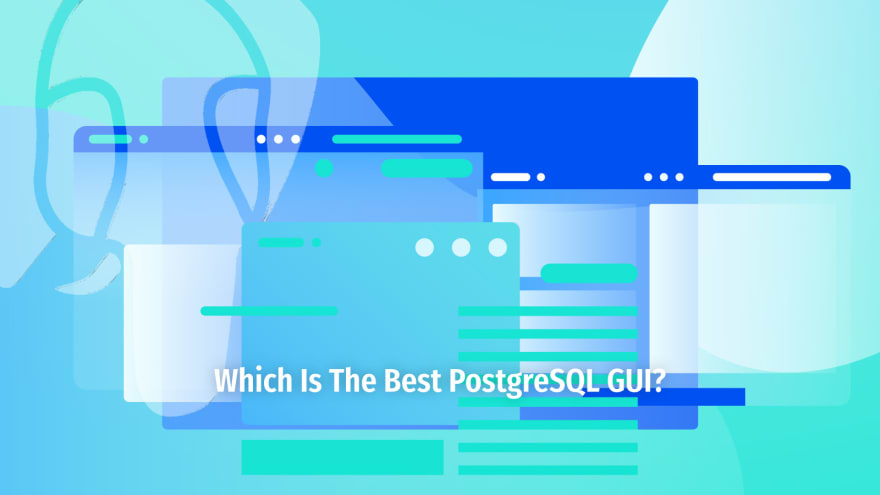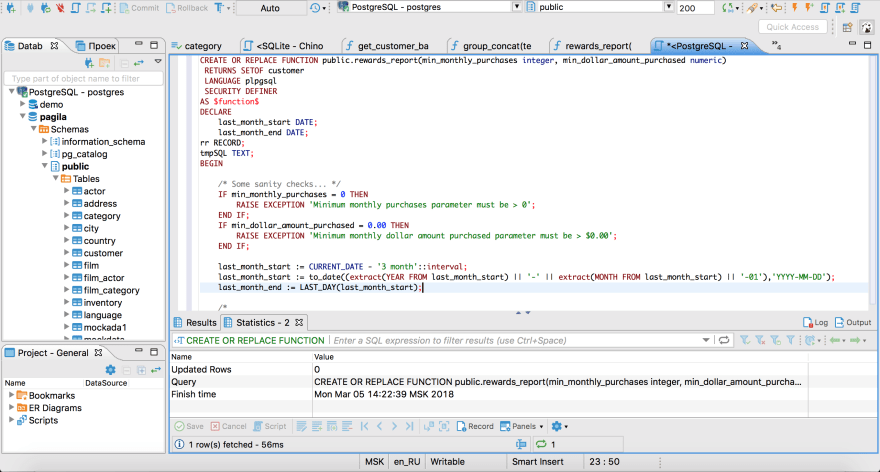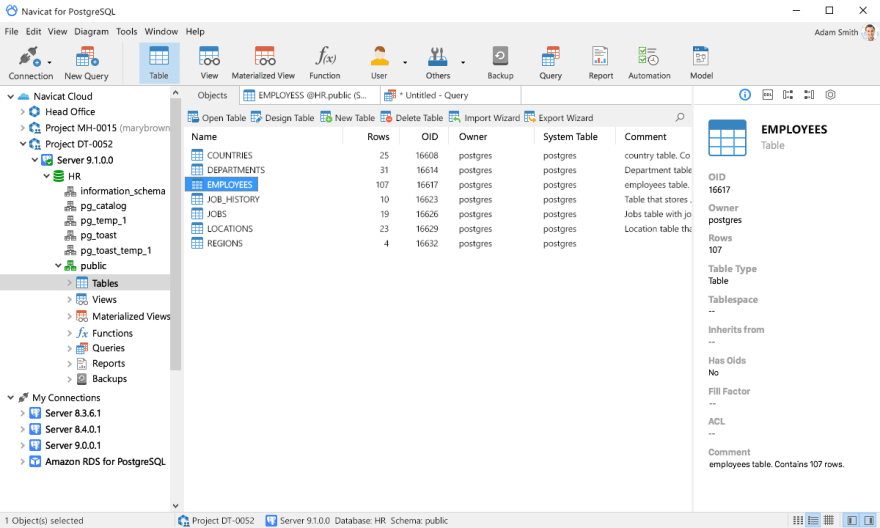PostgreSQL graphical user interface (GUI) tools help these open source database users to manage, manipulate, and visualize their data. In this post, we discuss the top 5 GUI tools for administering your PostgreSQL deployments. PostgreSQL is the fourth most popular database management system in the world, and heavily used in all sizes of applications from small to large. The traditional method to work with databases is using the command-line interface (CLI) tool, however, this interface presents a number of issues:
- It requires a big learning curve to get the best out of the DBMS.
- Console display may not be something of your like, and it only gives very little information at a time.
- It is difficult to browse database and tables, check indexes, and monitor databases through the console.
Many still prefer CLIs over GUIs, but this set is ever so shrinking. I believe anyone who comes to programming after 2010 will tell you GUI tools increase their productivity over a CLI solution.
Why Use a GUI Tool?
Now that we understand the issues users face with the CLI, let’s take a look at the advantages of using a PostgreSQL GUI:
- Shortcut keys make it easier to use, and much easier to learn for new users.
- Offers great visualization to help you interpret your data.
- You can remotely access and navigate another database server.
- The window-based interface makes it much easier to manage your PostgreSQL data.
- Easier access to files, features, and the operating system.
So, bottom line, GUI tools make PostgreSQL developers lives easier.
Top PostgreSQL GUI Tools
Today I will tell you about the 5 best PostgreSQL GUI tools. Let's start with the first and most popular one.
1. pgAdmin
pgAdmin is the de facto GUI tool for PostgreSQL, and the first tool anyone would use for PostgreSQL. It supports all PostgreSQL operations and features while being free and open-source. pgAdmin is used by both novice and seasoned DBAs and developers for database administration.
Here are some of the top reasons why PostgreSQL users love pgAdmin:
- Create, view and edit on all common PostgreSQL objects.
- Graphical query planning tool with syntax highlighting.
- The dashboard lets you monitor server activities such as database locks, connected sessions, and prepared transaction.
- Since pgAdmin is a web application, you can deploy it on any server and access it remotely.
- pgAdmin UI consists of detachable panels that you can arrange according to your likings.
- Procedural language debugger helps you to debug your code.
- pgAdmin has a portable version using which you can move your data between machines easily.
There are several cons of pgAdmin that users have generally complained about:
- The UI is slow and non-intuitive compared to paid GUI tools.
- pgAdmin uses too many resources.
pgAdmin can be used on Windows, Linux, and Mac OS. We listed it first as it's the most used GUI tool for PostgreSQL and it's the only native PostgreSQL GUI tool in our list. As it's dedicated exclusively to PostgreSQL, you can expect it to update with the latest features of each version. pgAdmin can be downloaded from their official website.
pgAdmin Cost: Free (open source)
2. DBeaver
DBeaver is a major cross-platform GUI tool for PostgreSQL that both developers and database administrators love. DBeaver is not a native GUI tool for PostgreSQL, as it supports all the popular databases like MySQL, MariaDB, Sybase, SQLite, Oracle, SQL Server, DB2, MS Access, Firebird, Teradata, and Derby.
Here are some of the top DBeaver GUI features:
- Visual Query builder helps you to construct complex SQL queries without actual knowledge of SQL.
- It has one of the best editors - multiple data views are available to support a variety of user needs.
- Convenient navigation among data.
- In DBeaver, you can generate fake data that looks like real data allowing you to test your systems.
- Full-text data search against all chosen tables/views with search results shown as filtered tables/views.
- Metadata search among rows in database system tables.
- Import and export data with many file formats such as CSV, HTML, XML, JSON, XLS, XLSX.
- Provides advanced security for your databases by storing passwords in secured storage protected by a master password.
- Automatically generated ER diagrams for a database/schema.
- Enterprise Edition provides a special online support system.
One of the cons of DBeaver is it may be slow when dealing with large data sets compared to some expensive GUI tools like Navicat and DataGrip.
You can run DBeaver on Windows, Linux, and macOS. It has a free and open-source as well an enterprise edition. You can buy the standard license for enterprise edition at $149. The free version is good enough for most companies. Especially most of the DBeaver users tell its free edition is better than pgAdmin.
DBeaver Cost: Free community, $149 standard license
3. Navicat
Navicat is an easy-to-use graphical tool that targets both beginner and experienced developers. It supports several database systems such as MySQL, PostgreSQL, and MongoDB. One of the special features of Navicat is its collaboration with cloud databases like Amazon Redshift, Amazon RDS, Amazon Aurora, Microsoft Azure, Google Cloud, Tencent Cloud, Alibaba Cloud, and Huawei Cloud.
Important features of Navicat:
- It has a very intuitive and fast UI. You can easily create and edit SQL statements with its visual SQL builder, and the powerful code auto-completion saves you a lot of time and helps you avoid mistakes.
- Navicat has a powerful data modeling tool for visualizing database structures, making changes, and designing entire schemas from scratch. You can manipulate almost any database object visually through diagrams.
- Navicat can run scheduled jobs and notify you via email when the job is done running.
- Navicat is capable of synchronizing different data sources and schemas.
- Navicat has an add-on feature (Navicat Cloud) that offers project-based team collaboration.
- Establish secure connections through SSH Tunneling and SSL ensures every connection is secure, stable, and reliable.
- You can import data from/export data to diverse formats like Excel, Access, CSV, and more.
Despite all the good features, there are a few cons that you need to consider before buying Navicat:
- The license is locked to a single platform. You need to buy different licenses for PostgreSQL and MySQL. Considering its heavy price, this is a bit difficult for a small company or a freelancer.
- It has many features that will take some time for a newbie to get going.
You can use Navicat in Windows, Linux, and Mac OS environments. The quality of Navicat is endorsed by its world-popular clients, including Apple, Oracle, Google, Microsoft, Facebook, Disney, and Adobe. Navicat comes in three editions called enterprise edition, standard edition, and non-commercial edition. Enterprise edition costs you $239, and the standard edition costs you $159 while even non-commercial edition cost you $89. You can get full price details here, and download the Navicat trial version for 14 days from here.
Navicat Cost: $89 up to $239 per license
4. DataGrip
DataGrip is a cross-platform integrated development environment (IDE) that supports multiple database environments. The most important thing about is DataGrip is developed by JetBrains, who is one of the leading brands for developing IDEs. If you have ever used PhpStorm, IntelliJ IDEA, PyCharm, WebStorm, you never need an introduction on how good JetBrains IDEs are.
There are many exciting features of why you would like DataGrip:
- The context-sensitive and schema-aware auto-complete feature suggests more relevant code completions.
- It has a beautiful and customizable UI along with an intelligent query console that keeps track of all your activities so you won’t lose your works. Moreover, you can easily add, remove, edit, and clone data rows with its powerful editor.
- Many ways to navigate between tables, views, and procedures.
- It can detect bugs in your code immediately and suggest the best options to fix them as well.
- It has an advanced refactoring process - when you rename a variable or an object, it can resolve all references automatically.
- DataGrip is just not a GUI tool for PostgreSQL, but a full-featured IDE that has features like version control systems.
There are a few cons in DataGrip:
- The obvious issue is that it's not native to PostgreSQL, so it lacks PostgreSQL-specific features. For example, it is not easy to debug errors as not all are able to be shown.
- Not only DataGrip, but most JetBrains IDE have a big learning curve making it a bit overwhelming for beginner developers.
- It consumes a lot of resources, like RAM, from your system.
DataGrip supports a tremendous list of database management systems, including SQL Server, MySQL, Oracle, SQLite, Azure Database, DB2, H2, MariaDB, Cassandra, HyperSQL, Apache Derby, and many more.
DataGrip supports all three major operating systems, Windows, Linux, and Mac OS. One of the downsides is that JetBrains products are comparatively costly. DataGrip has two different prices for organizations and individuals. DataGrip for Organizations will cost you $199 for the first year, $159 for the second year, and $119 for the third year onwards. The individual package will cost you $89 for the first year. You can test it out during the free 30 days trial period.
DataGrip Cost: $89 to $199 per year
5. OmniDB
The last item of our list is OmniDB. OmniDB lets you add, edit, and manage data and all other necessary features in a unified workspace. Although OmniDB supports other database systems like MySQL, Oracle, and MariaDB, their primary target is PostgreSQL. This open-source tool is mainly sponsored by 2ndQuadrant. OmniDB supports all three major platforms, namely Windows, Linux, and Mac OS X.
There are many reasons why you should use OmniDB for your Postgres developments:
- You can easily configure it by adding and removing connections.
- Smart SQL editor helps you to write SQL codes through autocomplete and syntax highlighting features.
- Complete debugging capabilities to PostgreSQL functions and procedures.
- You can monitor the dashboard from customizable charts that show real-time information about your database.
- Query plan visualization helps you find bottlenecks in your SQL queries.
- It let you access it from multiple computers with encrypted personal information.
- Developers can add and share new features via plugins.
There are a couple of cons with OmniDB:
- OmniDB lacks community support in comparison to pgAdmin and DBeaver. So, you might find it difficult to learn this tool, and could feel a bit alone when you face an issue.
- It doesn’t have as many features as in paid GUI tools like Navicat and DataGrip.
Anyway, its users have favorable opinions about it. You can download OmniDB from here.
OmniDB Cost: Free (open source)
Conclusion
Let’s summarize our top PostgreSQL GUI comparison. Almost everyone starts PostgreSQL with pgAdmin. It has great community support, and there are a lot of resources to help you if you face an issue. Usually, pgAdmin satisfies the needs of many developers to a great extent and thus, most developers do not look for other GUI tools. That’s why pgAdmin remains to be the most popular GUI tool.
If you are looking for an open source solution that has a better UI and visual editor, then DBeaver and OmniDB are great solutions for you. If you are looking for more features than what’s provided by an open source tool, and you’re ready to pay a good price for it, then Navicat and DataGrip are the best GUI products on the market.
While I believe one of these tools should surely support your requirements, there are other popular GUI tools for PostgreSQL that you might like, including Valentina Studio, Adminer, DB visualizer, and SQL workbench. I hope this article will help you decide which GUI tool suits your needs.












Latest comments (1)
I can add also a fast-growing postgresql ide dbForge Studio for PostgreSQL for postgres management and development. The PostgreSQL GUI allows users to create, develop, and execute queries, optimize queries with in-build profiler, edit, format and adjust the code to their requirements in a convenient and user-friendly interface. The tool also provides functionality for PostgreSQL data reporting, data editing, data import and export, building pivot tables and master-detail relations.